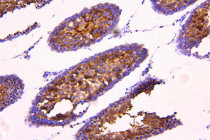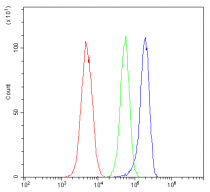ARG42698
anti-ACACB / Acetyl Coenzyme A Carboxylase 2 antibody
anti-ACACB / Acetyl Coenzyme A Carboxylase 2 antibody for Flow cytometry,IHC-Formalin-fixed paraffin-embedded sections,Western blot and Human,Mouse,Rat
Overview
| Product Description | Rabbit Polyclonal antibody recognizes ACACB / Acetyl Coenzyme A Carboxylase 2 |
|---|---|
| Tested Reactivity | Hu, Ms, Rat |
| Tested Application | FACS, IHC-P, WB |
| Host | Rabbit |
| Clonality | Polyclonal |
| Isotype | IgG |
| Target Name | Acetyl-CoA Carboxylase Beta |
| Antigen Species | Human |
| Immunogen | Synthetic peptide corresponding to a sequence of Human ACACB / Acetyl Coenzyme A Carboxylase 2. (EENPEVAVDCVIYLSQHISPAERAQVVHLLSTMD) |
| Conjugation | Un-conjugated |
| Alternate Names | Acetyl-CoA carboxylase 2; ACC-beta; HACC275; EC 6.4.1.2; EC 6.3.4.14; ACCB; ACC2 |
Application Instructions
| Application Suggestion |
|
||||||||
|---|---|---|---|---|---|---|---|---|---|
| Application Note | * The dilutions indicate recommended starting dilutions and the optimal dilutions or concentrations should be determined by the scientist. | ||||||||
| Observed Size | ~ 280 kDa |
Properties
| Form | Liquid |
|---|---|
| Purification | Affinity purification with immunogen. |
| Buffer | 0.2% Na2HPO4, 0.9% NaCl, 0.05% Sodium azide and 4% Trehalose. |
| Preservative | 0.05% Sodium azide |
| Stabilizer | 4% Trehalose |
| Concentration | 0.5 mg/ml |
| Storage Instruction | For continuous use, store undiluted antibody at 2-8°C for up to a week. For long-term storage, aliquot and store at -20°C or below. Storage in frost free freezers is not recommended. Avoid repeated freeze/thaw cycles. Suggest spin the vial prior to opening. The antibody solution should be gently mixed before use. |
| Note | For laboratory research only, not for drug, diagnostic or other use. |
Bioinformation
| Database Links | |
|---|---|
| Gene Symbol | ACACB |
| Gene Full Name | acetyl-CoA carboxylase beta |
| Background | Acetyl-CoA carboxylase (ACC) is a complex multifunctional enzyme system. ACC is a biotin-containing enzyme which catalyzes the carboxylation of acetyl-CoA to malonyl-CoA, the rate-limiting step in fatty acid synthesis. ACC-beta is thought to control fatty acid oxidation by means of the ability of malonyl-CoA to inhibit carnitine-palmitoyl-CoA transferase I, the rate-limiting step in fatty acid uptake and oxidation by mitochondria. ACC-beta may be involved in the regulation of fatty acid oxidation, rather than fatty acid biosynthesis. There is evidence for the presence of two ACC-beta isoforms. [provided by RefSeq, Jul 2008] |
| Function | Mitochondrial enzyme that catalyzes the carboxylation of acetyl-CoA to malonyl-CoA and plays a central role in fatty acid metabolism (PubMed:16854592, PubMed:19236960, PubMed:20457939, PubMed:20952656, PubMed:19900410, PubMed:26976583). Catalyzes a 2 steps reaction starting with the ATP-dependent carboxylation of the biotin carried by the biotin carboxyl carrier (BCC) domain followed by the transfer of the carboxyl group from carboxylated biotin to acetyl-CoA (PubMed:19236960, PubMed:20457939, PubMed:20952656, PubMed:26976583). Through the production of malonyl-CoA that allosterically inhibits carnitine palmitoyltransferase 1 at the mitochondria, negatively regulates fatty acid oxidation (By similarity). Together with its cytosolic isozyme ACACA, which is involved in de novo fatty acid biosynthesis, promotes lipid storage (By similarity). [UniProt] |
| Cellular Localization | Mitochondrion. Nucleus. Endomembrane system. Note=May associate with membranes. [UniProt] |
| Calculated MW | 277 kDa |
| PTM | Phosphorylated by AMPK, leading to inactivation of the enzyme. Required for the maintenance of skeletal muscle lipid and glucose homeostasis (By similarity). [UniProt] |
Images (3) Click the Picture to Zoom In
-
ARG42698 anti-ACACB / Acetyl Coenzyme A Carboxylase 2 antibody IHC-P image
Immunohistochemistry: Paraffin-embedded Rat testis tissue. Antigen Retrieval: Heat mediation was performed in EDTA buffer (pH 8.0). The tissue section was blocked with 10% goat serum. The tissue section was then stained with ARG42698 anti-ACACB / Acetyl Coenzyme A Carboxylase 2 antibody at 1 µg/ml dilution, overnight at 4°C.
-
ARG42698 anti-ACACB / Acetyl Coenzyme A Carboxylase 2 antibody WB image
Western blot: 50 µg of samples under reducing condition. Rat skeletal muscle and Mouse skeletal muscle lysates stained with ARG42698 anti-ACACB / Acetyl Coenzyme A Carboxylase 2 antibody at 0.5 µg/ml dilution, overnight at 4°C.
-
ARG42698 anti-ACACB / Acetyl Coenzyme A Carboxylase 2 antibody FACS image
Flow Cytometry: HL-60 cells were blocked with 10% normal goat serum and then stained with ARG42698 anti-ACACB / Acetyl Coenzyme A Carboxylase 2 antibody (blue) at 1 µg/10^6 cells for 30 min at 20°C, followed by incubation with DyLight®488 labelled secondary antibody. Isotype control antibody (green) was rabbit IgG (1 µg/10^6 cells) used under the same conditions. Unlabelled sample (red) was also used as a control.








